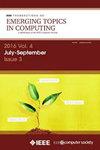结合基于时间和基于检查策略的高性价比软件复兴
IF 5.4
2区 计算机科学
Q1 COMPUTER SCIENCE, INFORMATION SYSTEMS
IEEE Transactions on Emerging Topics in Computing
Pub Date : 2024-10-11
DOI:10.1109/TETC.2024.3475214
引用次数: 0
摘要
软件恢复是一种主动维护技术,通过重新启动系统来抵消软件老化,使恢复时间的选择至关重要,以提高可靠性,而不会产生过多的停机成本。软件老化与再生(SAR)的各种随机模型已经被开发出来,大多数在使能限制下具有连续时间马尔可夫链(ctmc),半马尔可夫过程(SMPs)和马尔可夫再生过程(MRGPs)类的潜在随机过程,要求在每个状态下最多启用一个通用(GEN),即非指数定时器。在有限再生限制下,我们提出了一个具有底层MRGP的SAR模型,允许在每个状态下并发启用多个GEN计时器。这种表达性增益不仅支持从观察到的统计数据中更准确地拟合持续时间分布,而且还可以定义结合基于时间和基于检查的策略的混合恢复策略,其中下一次检查或恢复的时间取决于诊断测试的结果。实验结果表明,将GEN定时器替换为具有相同平均值的指数定时器(以满足使能限制)会产生不准确的恢复策略,混合恢复在最大化可靠性方面优于基于时间的恢复,尽管代价是可用性的可接受降低。本文章由计算机程序翻译,如有差异,请以英文原文为准。
Cost-Effective Software Rejuvenation Combining Time-Based and Inspection-Based Policies
Software rejuvenation is a proactive maintenance technique that counteracts software aging by restarting a system, making selection of rejuvenation times critical to improve reliability without incurring excessive downtime costs. Various stochastic models of Software Aging and Rejuvenation (SAR) have been developed, mostly having an underlying stochastic process in the class of Continuous Time Markov Chains (CTMCs), Semi-Markov Processes (SMPs), and Markov Regenerative Processes (MRGPs) under the enabling restriction, requiring that at most one general (GEN), i.e., non-Exponential, timer be enabled in each state. We present a SAR model with an underlying MRGP under the bounded regeneration restriction, allowing for multiple GEN timers to be concurrently enabled in each state. This expressivity gain not only supports more accurate fitting of duration distributions from observed statistics, but also enables the definition of mixed rejuvenation strategies combining time-based and inspection-based policies, where the time to the next inspection or rejuvenation depends on the outcomes of diagnostic tests. Experimental results show that replacing GEN timers with Exponential timers with the same mean (to satisfy the enabling restriction) yields inaccurate rejuvenation policies, and that mixed rejuvenation outperforms time-based rejuvenation in maximizing reliability, though at the cost of an acceptable decrease in availability.
求助全文
通过发布文献求助,成功后即可免费获取论文全文。
去求助
来源期刊

IEEE Transactions on Emerging Topics in Computing
Computer Science-Computer Science (miscellaneous)
CiteScore
12.10
自引率
5.10%
发文量
113
期刊介绍:
IEEE Transactions on Emerging Topics in Computing publishes papers on emerging aspects of computer science, computing technology, and computing applications not currently covered by other IEEE Computer Society Transactions. Some examples of emerging topics in computing include: IT for Green, Synthetic and organic computing structures and systems, Advanced analytics, Social/occupational computing, Location-based/client computer systems, Morphic computer design, Electronic game systems, & Health-care IT.
 求助内容:
求助内容: 应助结果提醒方式:
应助结果提醒方式:


